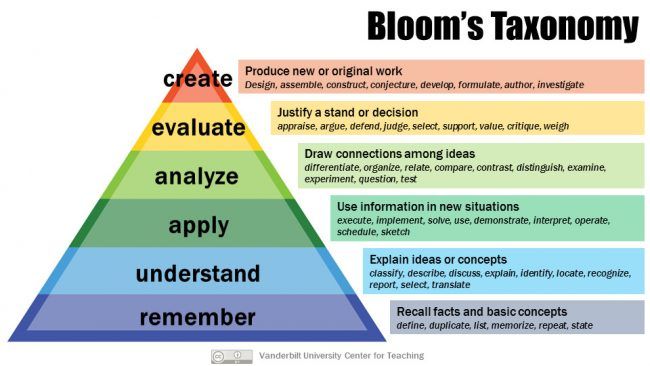
Critical thinking is one of the key goals and expectations of academic learning. Scholars in a range of fields (but especially philosophy, psychology, and education) have attempted to define what qualities make up what we call critical thinking, but one key aspect is the expectation that that we will master existing knowledge so that we are as well-positioned as we can be to revise existing understandings and create new knowledge.1
One of the more influential models of critical thinking in the field of education is Bloom's Taxonomy, originally published in 1956 by educational psychologist Benjamin Bloom and a group of collaborators as A Taxonomy of Educational Objectives and later revised in 2001 by "A group of cognitive psychologists, curriculum theorists and instructional researchers, and testing and assessment specialists" as A Taxonomy for Teaching, Learning, and Assessment.2
This model of learning emphasizes that we need to come to grips with the existing state of knowledge in a field -- recalling facts and basic concepts -- in order to build up to higher order tasks like understanding, applying, analyzing, evaluating, and creating knowledge ourselves.

Some students come into college believing that if they simply memorize a bunch of facts about a topic, use impressive words, and repeat them accurately and in the correct format, that will lead to a high grade. However academic culture comes with a different set of expectations. We are expected to go beyond remembering and understanding facts.
In academic writing, we aim to become full participants in an ongoing scholarly discourse, the discussion about our topic that is already taking place among experts in our field. This requires us to understand, apply, analyze, and evaluate the existing scholarly discussion about our topic, and engage with the evidence to contribute our own findings (They Say, I Say).
Citations
1Lai, Emily R. "Critical thinking: A literature review." Pearson Assessments, 2011. URL: http://images.pearsonassessments.com/images/tmrs/CriticalThinkingReviewFINAL.pdf
2Armstrong, P. (2010). Bloom’s Taxonomy. Vanderbilt University Center for Teaching. Retrieved October 9, 2022 from https://cft.vanderbilt.edu/guides-sub-pages/blooms-taxonomy/.
In chapter 2 of his book, Writing in Response on "Active Reading," Matthew Parfitt discusses the following strategies for critically reading a text:
Parfitt also explains how to keep a Reading Journal to keep track of your own thoughts, and offers a number of further strategies for analyzing and evaluating the author's arguments, mapping the text, and ensuring that we represent the author's ideas fairly and accurately when we cite and respond to them in our papers.
This work is licensed under CC BY-NC-SA 4.0